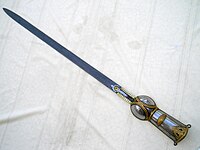Pata (sword)
| Pata | |
|---|---|
 A Pata, with an Ornamental gauntlet and a 41" (104 cm) blade | |
| Type | Sword |
| Place of origin | India |
| Service history | |
| Used by | Rajputs, Mughals, Marathas |
| Specifications | |
| Length | 10-44" (25-114 cm) |
| Blade type | Double-edged, straight bladed |
| Hilt type | Gauntlet type hilt |
A Pata (Hindi: पट) or sword gauntlet is a bladed weapon of Mughal period India, much like a short sword, except that the blade is integrated in a gauntlet.
In use, it could be employed as a Katara (कटार), though the additional support from being laid along the forearm may have allowed them to be used as a slashing weapon too. It was considered to be a highly effective weapon for Infantrymen against heavily armoured cavalry.[citation needed] The Pata gradually evolved from the 10 inch (25 cm) long Katar to sometimes as long as 44 inch (114 cm) blade length.[citation needed]
Use of the pata in warfare appears to be mostly restricted to the 17th century. Shivaji is reported as a prominent user of this weapon during his time. One of his generals, Tanaji Malusare, used the weapon with both his hands during the Battle of Sinhagad, before one of his hands was cut off. In the Battle of Pratapgad, when Afzal Khan's bodyguard Sayyed Banda attacked Shivaji with swords, Jiva Mahala, Shivaji's personal bodyguard fatally struck him down, cutting off one of Sayyed Banda's hands with a Dandpatta.[citation needed] Emperor Akbar also used this weapon during the siege of Gujarat. The rajput warriors are known to have used this weapon very effectively during the Mughal period.
The Mughals also developed variations of Pata with matchlock pistols adjoining the handle too.[citation needed]
One of the best collections of this weapon can be seen at the Durbar Hall, Shiva Nivas Palace, at Udaipur, Rajasthan. The erstwhile rulers – the Royal Family of Mewar owns the collection. It is displayed along with many other bladed weapons.[citation needed]
